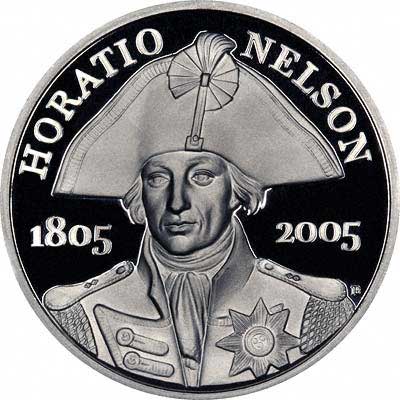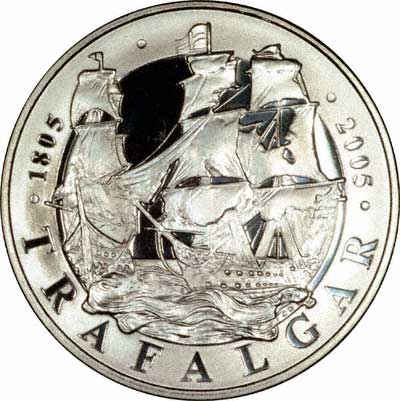| The Very Highest Quality Coins... |
| 1805 - 2005 Admiral Horatio Nelson and the Battle of Trafalgar |
|

|
|
|

|
|
|
Early Life
Horatio Nelson was born on 29th September 1758 at Burnham Thorpe in Norfolk, son of the local rector and parish priest, the Rev. Edmund Nelson. A sickly and delicate child, Horatio was a constant worry to his father, especially after Catherine, Horatio's mother, died in 1767. On 1st January 1771 Horatio, aged 12, joined the Royal Navy as an ordinary seaman on his uncle's ship Raissonable. He loved being at sea and his enthusiasm was noted - he was promoted to midshipman and began studying to be an officer.
Becoming captain in 1779, Nelson's first ship was the frigate Hitchenbroke. His first conflict with the Spanish occurred in 1781 when he attacked the fortress of San Juan in Nicaragua. With the end of the American Revolutionary War in 1783 his career seemed to stagnate. However, war clouds were gathering in Europe as the effects of the French Revolution reached crisis level. In 1793 Nelson was recalled to front line duty and took command of the 64-gun ship Agamemnon. During a skirmish near Corsica in 1794 Nelson lost the sight in his right eye; he did not wear an eye-patch, contrary to public belief, but did use a sun-shade for his remaining eye!
On to Victory...
The four years from 1797 to 1801 were a time of spectacular success and popularity for Nelson. He ensured the defeat of the Spanish fleet at Cape St. Vincent near Gibraltar on 14th February 1797 and he was promoted to Rear Admiral. He defeated Napoleon's fleet in Egypt at the Battle of the Nile on 1st August 1798, Napoleon himself having to flee from Egypt as a refugee! Nelson then helped to rescue the Neapolitan royal family from a French invasion. It was during this stay in Naples that he met and fell in love with Emma Hamilton, wife of the British ambassador to Naples. On 1st April 1801 Nelson defeated the Danish fleet at the Battle of Copenhagen; the sinister neutrality of Denmark, Sweden and Russia worried the British who still faced Napoleon's armies across the English Channel. After his success in the Baltic, Nelson was appointed as commander-in-chief of the Mediterranean fleet and he took command of HMS Victory in May 1803.
...and Trafalgar!
After several abortive attempts at diplomacy with Napoleon, Nelson was asked to confront the French and Spanish fleets which had managed to unite and take refuge in the harbour at Cadiz in Spain. On 21st October 1805 Nelson ordered his fleet of twenty seven ships to attack the opposing enemy fleet of thirty-three ships. As the fleets approached each other Nelson had the thirty-one flags hoisted which signalled to the rest of the fleet the famous message 'England expects that every man will do his duty'. After crippling the French flagship Beaucentaure the Victory sailed towards the Redoutable. There were groups of snipers in the rigging of this ship who proceeded to fire round after round at the deck of the Victory. Nelson was one of those hit; the musket round penetrated his shoulder, hit his lung and lodged near his spine. Nelson survived the battle, acknowledging the British victory, but he died soon afterwards.
UK Commemorative Coins
In 2005 the Royal Mint will be issuing commemorative crowns of Lord Admiral Nelson and the Battle of Trafalgar.
If you want to find the value of a coin you own, please take a look at our page I've Found An Old Coin, What's It Worth?
| ...at the Lowest Possible Price |
|
32 - 36 Harrowside, Blackpool, Lancashire, FY4 1RJ, England. Telephone (44) - (0) 1253 - 343081 ; Fax 408058; E-mail: The URL for our main page is: https://24carat.co.uk | Chard(1964) Ltd |